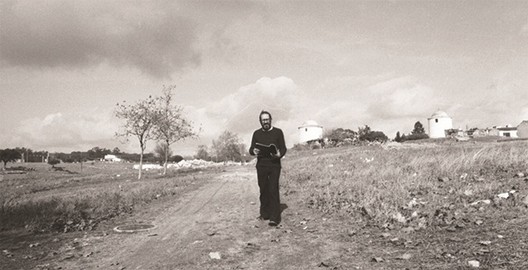
In an essay and accompanying mini-documentary film by Ellis Woodman for The Architectural Review, Siza's iconic Quinta da Malagueira housing estate (1973-1977) in Évora, Portugal, is comprehensively explored and examined with a refreshingly engaging critical weight. Rather than develop multi-story housing in the sensitive landscape around the city, Siza proposed "a plan that distributed the programme between two fields composed of low-rise terraced courtyard houses." As a result, the arrangement of these structures adjust to the "undulating topography ensuring that the narrow, cobbled streets along which the houses are distributed always follow the slope."
As is made clear in the film (above), one of the remarkable aspects about the Quinta da Malagueira estate is that it is "governed by a third layer of infrastructure" which takes the form of "an elevated network of conduits that distributes water and electricity [...] much in the manner of a miniature aqueduct." For Siza, this was a logical move as it provided the cheapest means of distributing utilities around the complex. Woodman ultimately concludes that "Siza’s work at Malagueira invites a reading less as a fixed artefact and rather as one episode in the site’s ongoing transformation."
Read extracts of what Pier Vittorio Aureli, Tony Fretton, and John Tuomey (among others) have said about Siza's œuvre and approach after the break.


For Tony Fretton, (Tony Fretton Architects) "Siza’s buildings are full of generous non-rhetorical lessons for architectural practice." He believes that in Quinta da Malagueira a new piece of the city is made, "with exceptional skill and conviction." In this instance it is done through just the form and imagery of infrastructure and row housing and their subtle relations to the surrounding terrain. For Fretton, it is through "simple pleasures" that "a massive holistic statement is made about architecture’s capacity to reconcile human folly and the need to live optimistically."
Pier Vittorio Aureli (DOGMA) describes Quinta da Malagueira as "perhaps the last great ‘social housing project’. That is, it is the last great architectural contribution to the city in which architecture plays a fundamental role." The uniqueness of this project, for Aureli, comes from the marriage of "formal principles and political intentions" in one project. "Conceived with exceptional momentum" (after the revolution of 1974 in Portugal), Aureli believes that "the memory of ancient Roman architecture and the spartan logic of Modernist housing had their first and sadly last felicitous meeting," such as in the raised aqueducts in which "infrastructure’s matter-of-factness becomes the opportunity to create a form that is stubbornly monumental yet anonymous."
Peter St John (Caruso St. John) argues that "it’s difficult to describe the importance of Álvaro Siza’s architecture in a few words because his work is so subtle and witty, and his interpretations have many layers of meaning." In spite of their ability to "communicate with their context," they achieve "something else" through their commanding approach that ultimately achieves something "abstract and deeply moving." St. John believes that "unlike other famous architects, he’s always doing things that are useful to society."
For Jonathan Woolf (Jonathan Woolf Architects) argues that "Siza’s capacity to work meaningfully within a wide range of settings and building types is neither adolescent nor predictable." It is his "gift for observation regarding the nature of a place, to absorb what may at first appear insignificant things here or there, and recast them into an emotionally resonant proposal of authenticity" that is such an influence. "It is an approach that embraces doubt and remains radical."
John Tuomey (O'Donnell + Tuomey) "admits to admiring at least three aspects of his esoteric fluency." Firstly, "site geomancy" plays an important role: "his poetic understanding of the site conditions only reveals itself through our spatial experience of the built reality." Secondly, "Siza thinks his projects out through drawing. [...] He turns a building over in his mind’s eye, and examines little details from different perspectives. Drawing seems to help him see around corners." Thirdly, the notion of "supple volumes [...] invite us to move more alertly through space, keeping our eyes wide open all around."
For William Mann (Witherford Watson Mann), "Siza’s buildings have an economy of means, a nimble opportunism and a quiet generosity." What is remarkable is that he has "sustained a quality of reflection and enquiry over six decades." For Mann, Siza's work is "grounded in an understanding of the complex relation between people and buildings − the small gestures that invite occupation, the slow shifts of architectural culture."
Read these statements in full, plus an extended essay by Ellis Woodman, on The Architectural Review.


